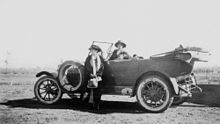| This article needs additional citations for verification. Please help improve this article by adding citations to reliable sources. Unsourced material may be challenged and removed. Find sources: "Running board" – news · newspapers · books · scholar · JSTOR (July 2008) (Learn how and when to remove this message) |



A running board or footboard is a narrow step fitted under the side doors of a tram (cable car, trolley, or streetcar in North America), car, or truck. It aids entry, especially into high vehicles, and is typical of vintage trams and cars, which had much higher ground clearances than today's vehicles. It is also used as a fashion statement on vehicles that would not otherwise require it. The origin of the name running board is obscure; the first running boards predate automobiles and were installed on carriages as early as the 17th century.
History
Rail
Anyone who still wanted to go from compartment to compartment while the train was moving had to scramble over the externally mounted running board. The German "Trittbrettfahrer" (riding on the running board) now has the proverbial meaning "free-rider (non-paying users)".
— https://artsandculture.google.com/exhibit/about-corridor-trains-and-running-board-riders-deutsches-technikmuseum/SwJCL1iArMIyLA?hl=en
The term also applied to the walkways on top of railway/railroad boxcars. Originally, they were used by brakemen to travel from car to car to apply hand-operated brakes. With the adoption of the air brake this practice was abandoned. However the running board was still used as an observation point to pass hand signals to the train driver (train engineer in North America) when cars were being shunted (switched in North America). The increased use of radio communication made this unnecessary. Today, most countries forbid anyone to be atop a moving freight car.
Automobile
In the early 20th century, all automobiles were equipped with running boards. The necessity of using them was caused by the fact that first cars were designed with a narrow, high body bolted to the chassis. Most roads were unpaved and tall narrow wheels and tires were needed to get through the ruts, mud, and snow. A running board served as a step to a vehicle's cabin, and sometimes could be wide enough to serve as a place to sit or even lie down for an adult.
During the 1920s and 1930s, car design was evolving rapidly to become more sleek and aerodynamic, which largely eliminated the need for running boards. The first automobile designed without running boards was the 1929 Ruxton, and the first by a high production manufacturer was the 1936 Cord. The Cord changed the attitude towards running boards for many years ahead.
Common materials for running boards include aluminum, fiberglass, stainless steel and ABS plastic.
See also
References
- US 5193829 "Sub frame support system and running board for a vehicle"
- "What Are Running Boards?". Auto. August 30, 2022.
- "How To Install Running Boards?". Auto. August 30, 2022.
- "The Mythical Ruxton - The greatest American car that never really was". Collier Automedia. 2021-01-21. Retrieved 2021-02-25.
- "What are running boards?". MOSTPLUS. 2023-11-23. Retrieved 2024-05-14.
| Automotive design | |||||||||||||
|---|---|---|---|---|---|---|---|---|---|---|---|---|---|
| Part of a series of articles on cars | |||||||||||||
| Body |
| ||||||||||||
| Exterior equipment |
| ||||||||||||